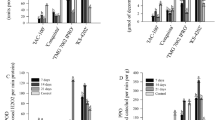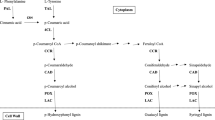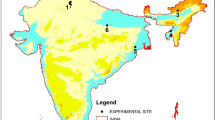Abstract
Southern chinch bug, Blissus insularis Barber (Hemiptera: Blissidae), is a serious insect pest of St. Augustinegrass, Stenotaphrum secundatum (Walt.) Kuntze, a turfgrass commonly grown in the southeastern United States. Resistance to southern chinch bug has been identified in the polyploid St. Augustinegrass varieties ‘Floratam’ and ‘FX-10’, and the diploid ‘Captiva’. However, southern chinch bug in Florida and elsewhere has overcome Floratam’s resistance. This research investigated the potential role of selected plant oxidative enzymes in resistance/susceptibility to southern chinch bug in two polyploid varieties (FX-10 and Floratam) and two diploid varieties (Captiva and Palmetto). Oxidative enzyme activity was estimated spectrophotometrically from plant samples collected 1, 3, 5, and 8 days after southern chinch bug infestation and from uninfested control plants. Resistant FX-10 and Captiva had significantly higher peroxidase activity, while Captiva had significantly higher polyphenol oxidase activity 5 and 8 days after infestation compared to uninfested controls. FX-10 had higher lipoxygenase activity 3, 5, and 8 days after infestation compared to uninfested controls. Catalase activities did not differ between infested and control plants in any of the varieties tested. Native gels stained for peroxidase indicated that certain isozymes in FX-10 and Captiva were induced 5 and 8 days after infestation. Isozyme profiles of polyphenol oxidase and lipoxygenase did not differ between control and infested FX-10, Floratam, Captiva, and Palmetto. Potential mechanisms to explain the correlation of resistance to southern chinch bug in FX-10 and Captiva with higher activities of oxidative enzymes are discussed.






Similar content being viewed by others
References
Bi, J. L., Murphy, J. B. A., and Felton, G. W. 1997. Antinutritive and oxidative components as mechanisms of induced resistance in cotton to Helicoverpa zea. J. Chem. Ecol. 23:97–117.
Brisson, L. F., Tenhaken, R., and Lamb, C. 1994. Function of oxidative cross-linking of cell wall structural proteins in plant disease resistance. Plant Cell 6:1703–1712.
Busey, P. 1993. Registration of FX-10 St. Augustinegrass. Crop Sci. 33:214–215.
Busey, P. and Center, B. J. 1987. Southern chinch bug (Hemiptera: Heteroptera: Lygaeidae) overcomes resistance in St. Augustinegrass. J. Econ. Entomol. 80:608–611.
Cardoza, Y. J., Reidy-Crofts, J., and Edwards, O. R. 2005. Differential inter- and intra-specific defense induction in Lupinus by Myzus persicae feeding. Entomol. Exp. Appl. 117:155–163.
Chaman, M. E., Corcuera, L. J., Zuniga, G. E., Cardemil, L., and Argandona, V. H. 2001. Induction of soluble and cell wall peroxidases by aphid Infestation in Barley. J. Agri. Food Sci. 49:2249–2253.
Cherry, R. H. 2001. Seasonal wing polymorphism in southern chinch bugs (Hemiptera:Lygaeidae). Fla. Entomol. 84:737–39.
Cherry, R. H. and Nagata, R. T. 2005. Development of resistance in southern chinch bug (Hemiptera: Lygaeidae) to the insecticide bifenthrin. Fla. Entomol. 88:219–221.
Cherry, R. H. and Nagata, R. T. 2007. Resistance to two classes of insecticides in southern chinch bugs (Hempitera: Blissidae). Fla. Entomol. 90:431–434.
Chittoor, J. M., Leach, J. E., and White, F. F. 1999. Induction of Peroxidase During Defense Against Pathogens, pp. 171–193, in S. K. Datta and S. Muthukrishnan (eds.). Pathogenesis-Related Proteins in Plants. CRC, Boca Raton.
Constabel, C. P., Bergey, D. R., and Ryan, C. A. 1996. Polyphenol Oxidase as a Component of the Inducible Defense Response in Tomato against Herbivores, pp. 231–252, in J.T. Romeo, J. A. Saunders, and P. Barbosa, (eds.). Phytochemical Diversity and Redundancy in Ecological Interactions. Plenum, New York.
Constabel, C. P., Peter, Y., Lynn, P., Joseph, J., and Christopher, M. E. 2000. Polyphenol oxidase from hybrid poplar: cloning and expression in response to wounding and herbivory. Plant Physiol. 124:285–296.
Crocker, R. L. 1993. Chemical control of southern chinch bug in St. Augustinegrass. Int. Turfgrass Soc. Res. J. 7:358–365.
Dicke, M., Gols, R., Ludeking, D., and Posthumus, M. A. 1999. Jasmonic acid and herbivory differentially induce carnivore-attracting plant volatiles in lima bean plants. J. Chem. Ecol. 25:1907–1922.
Dowd, P. F. and Lagrimini, L. M. 1997. The Role of Peroxidase in Host Insect Defenses, pp. 195–223, in J. N. Carozzi and M. Koziel (eds.). Advances in Insect Control: The Role of Transgenic Plants. Taylor and Francis, London.
Duffy, S. S. and Felton, G. W. 1991. Enzymatic Antinutritive Defenses of the Tomato Plants against Insects, pp. 167–197, in P. A. Hedin (ed.). Naturally Occurring Pest Bioregulators. ACS symposium Series 449, Dallas, 1989. American Chemical Society, Washington, DC.
Faccioli, G. 1979. Relation of peroxidase, catalase, and polyphenoloxidase to acquired resistance in plants of Chenopodium amaranticolor locally infected by tobacco necrosis virus. Phytopathology 95:237–249.
Felton, G. W., Donato, R. J., Vecchio, D., and Duffey, S. S. 1989. Activation of plant foliar oxidases by insect feeding reduces nutritive quality of foliage for noctuid herbivores. . J. Chem. Ecol. 15:2667–2694.
Felton, G. W., Summers C. B, and Mueller, A. J. 1994a. Oxidative responses in soybean foliage to herbivory by bean leaf beetle and three-corned alfalfa leafhopper. J. Chem. Ecol. 20:639–650.
Felton, G. W., Bi, J., Summers, C. B., Mueller, A. J., and Duffey, S. S. 1994b. Potential role of lipoxygenases in defense against insect herbivory. J. Chem. Ecol. 20:651–666.
Fidantsef, A. L., Stout, M. J., Thaler, J. S., Duffey, S. S., and Bostock, R. M. 1999. Signal interactions in pathogen and insect attack: expression of lipoxygenase, proteinase inhibitor II, and pathogenesis-related protein P4 in the tomato, Lycopersicon esculentum. Physiol. Mol. Plant Pathol. 54:97–114.
Gardner, H. W. 1979. Lipid hydroperoxide reactivity with proteins and amino acids: a review. J. Agri. Food Chem. 27:220–228.
Gardner, H. W. 1991. Recent investigations into the lipoxygenase pathway of plants. Biochimi. Biophys. Acta 1084:221–239.
Green, T. R., and Ryan, C. A. 1972. Wound-induced proteinase inhibitor in plant leaves: a possible defense mechanism against insects. Science 175:776–777.
Haydu, J. J., Satterthwaite, L. N., and Cisar, J. L. 2005. An economic and agronomic profile of Florida’s sod Industry in 2003. Institute of Food and Agricultural Sciences University of Florida, Gainesville. pp 38: (http://edis.ifas.ufl.edu/pdffiles/FE/FE56100.pdf).
Heinisch, O., Kowalski, E, Ludwig, H, and Tauscher B. 1996. Staining for soybean lipoxygenase activity in electrophoretic gels. Fett/Lipid 98:183–184.
Heng-Moss, T. M., Sarath, G., Baxendale, F., Novak, D., Bose, S., Ni, X., and Quisenberry, S. 2004. Characterization of oxidative enzyme changes in buffalograsses challenged by Blissus occiduus. J. Econ. Entomol. 97:1086–1095.
Hildebrand, D. F., Rodriguez, J. G., Brown, G. C., Luu, K. T., and Volden, C. S. 1986. Peroxidative responses of leaves in two soybean genotypes injured by twospotted spider mites (Acari: Tetranychidae). J. Econ. Entomol. 79: 1459–1465.
Hori, K., Wada, A., and Shibuta, T. 1997. Changes in phenoloxidase activities of the galls on leaves of Ulmus davidana formed by Tetraneura fusiformis (Homoptera: Eriosomatidae). Appl. Entomol. Zool. 32:365–371.
Horn, G. C., Dudeck, A. E., and Toler, R. W. 1973. ‘Floratam’ St. Augustinegrass: a fast growing new variety for ornamental turf resistant to decline and chinch bugs. Fla. Agric. Exp. Sta. Circ. S-224.
Kanofsky, J. R. and Axelrod, B. 1986. Singlet oxygen production by soybean lipoxygenase isozymes. J. Biol. Chem. 261:1099–1104.
Kessler, A. and Baldwin, I. T. 2002. Plant responses to insect herbivory: the emerging molecular analysis. Annu. Rev. Plant Biol. 53:299–328.
Kessler, A., Halitschke, R., and Baldwin, I. T. 2004. Silencing the jasmonate cascade: induced plant defenses and insect populations. Science 305:665–668.
Khattab, H. 2007. The defense mechanism of cabbage plant against phloem-sucking aphid (Brevicoryne brassicae L.). Aust. J. Basic Appl. Sci.1:56–62.
Koch, E., Meier, B. M., Eiben, H.-G., and Slusarenko, A. 1992. A lipoxygenase from leaves of tomato (Lycopersicon esculentum Mill.) is induced in response to plant pathogenic Pseudomonads. Plant Physiol. 99:571–576.
Kogan, M. 1994. Plant Resistance in Pest Management, pp. 73–128, in R.L. Metcalf and W.H. Luckman (eds.). Introduction to Insect Pest Management. Wiley, New York.
Kowalski, S. P., Eannetta, N. T., Hirzel, A. T., and Steffens, J. C. 1992. Purification and characterization of polyphenol oxidase from glandular trichomes of Solanum berthaultii. Plant Physiol. 100:677–684.
Kranthi, S., Kranthi, K. R., and Wanjari, R. R. 2003. Influence of semilooper damage on cotton host-plant resistance to Helicoverpa armigera (Hub). Plant Sci. 164:157–163.
Lowry, O. H., Rosebrough, N. J., Farr, A. L., and Randall, R. J. 1951. Protein measurement with Folin phenol reagent. J. Biol. Chem. 193:265–275.
Lucarini, A. C. and Kilikian, B. V. 1999. Comparative study of Lowry and Bradford methods: interfering substances. Biotech. Tech. 13:149–154.
Ludlum, C. T., Felton, G. W., and Duffey, S. S. 1991. Plant defenses: chlorogenic acid and polyphenol oxidase enhance toxicity of Bacillus thuringiensis subsp.kurstaki to Heliothis zea. J. Chem. Ecol. 17:217–237.
Mao, J., Burt, A. J., Ramputh, A. I., Simmonds, J., Cass, L., Hubbard, K., Miller, S., Altosaar, I., and Arnason, J. T. 2007. Diverted secondary metabolism and improved resistance to European corn borer (Ostrinia nubilalis) in maize (Zea mays L.) transformed with wheat oxalate oxidase. J. Agri. Food Chem. 55:2582–2589.
Matkovics B, and Szabo L, Si, V. 1981. Study of host-parasite interaction in tomato plants. Acta Univ. Szegediensi Acta Biolog. 27:17–23.
Miller, H., Porter, D. R., Burd, J. D., Mornhinweg, D. W., and Burton, R. L. 1994. Physiological effects of Russian wheat aphid (Homoptera: Aphididae) on resistant and susceptible barley. J. Econ. Entomol. 87:493–499.
Mohri, S., Endo, Y., Matsuda, K., Kitamura, K., and Fujimoto, K. 1990. Physiological effects of soybean seed lipoxygenases on insects. Agrl. Biol. Chem. 54:2265–2270.
Nagata, R. T. and Cherry, R. H. 2003. New source of chinch bug (Hemiptera: Lygaeidae) resistance in a diploid selection of St. Augustinegrass. J. Entomol. Sci. 38:654–659.
Ni, X., Quisenberry, S. S., Heng-Moss, T., Markwell, J., Sarath, G., Klucas, R., and Baxendale, F. 2001. Oxidative responses of resistant and susceptible cereal leaves to symptomatic and nonsymptomatic cereal aphid (Hemiptera: Aphididae) feeding. J. Econ. Entomol. 94:743–751.
Orozco-Cardenas, M. L., Narvaez-Vasquez, J., and Ryan, C. A. 2001. Hydrogen peroxide acts as a second messenger for the induction of defense genes in tomato plants in response to wounding, systemin, and methyl jasmonate. Plant Cell 13:179–191.
Park, S.-J., Huang, Y., and Ayoubi, P. 2006. Identification of expression profiles of sorghum genes in response to greenbug phloem-feeding using cDNA subtraction and microarray analysis. Planta 223:932–947.
Patrick J. M, Cheng, Y., Cassell, J. L., and Thompson, G. A. 2002. Gene expression profiling of Arabidopsis thaliana in compatible plant-aphid interactions. Arch. Insect Biochem. Physiol. 51:182–203.
Pierpoint, W. S. 1983. Reactions of Phenolic Compounds with Proteins, and their Relevance to the Production of Leaf Protein, pp. 235–267, in L. Telek and H. Graham (eds.). Leaf Protein Concentrates. Avi, Westport, Connecticut.
Rafi, M. M., Zemetra, R. S., and Quisenberry, S. S. 1996. Interaction between Russian wheat aphid (Homoptera: Aphididae) and resistant and susceptible genotypes of wheat. J. Econ. Entomol. 89:239–246.
Ramiro, D., Guerreiro-Filho, O., and Mazzafera, P. 2006. Phenol contents, oxidase activities, and the resistance of coffee to the leaf miner, Leucoptera coffeella. J. Chem. Ecol. 32:1977–1988.
Rangasamy, M., Mcauslane, H. J., Cherry, R. H., and Nagata, R. T. 2006. Categories of resistance in St. Augustinegrass lines to southern chinch bug (Hemiptera: Blissidae). J. Econ. Entomol. 99:1446–1451.
Rangasamy, M., B. Rathinasabapathi, H. J. Mcauslane, R. H. Cherry, and R. T. Nagata. 2009. Role of leaf sheath lignification and anatomy in resistance against southern chinch bug, Blissus insularis Barber (Hemiptera: Blissidae), in St. Augustinegrass. J. Econ. Entomol. 102: 432–439.
Rayapuram, C., and Baldwin, I. T. 2006. Using nutritional indices to study LOX3-dependent insect resistance. Plant Cell Environ. 29:1585–1594.
Reinert, J. A. and Portier, K. 1983. Distribution and characterization of organophosphate-resistant southern chinch bugs (Heteroptera: Lygaeidae) in Florida. J. Econ. Entomol. 76:1187–1190.
Ruuhola, T. and Yang, S. 2006. Wound-induced oxidative responses in mountain birch leaves. Ann. Bot. 97:29–37.
Sas. 1999. SAS/STAT user’s Guide. SAS Institute, Cary.
Sauer, J. D. 1972. Revision of Stenotaphrum (Gramineae: Paniceae) with attention to its historical geography. Brittonia 24:202–222.
Shukle, R. H. and Murdock, L. L. 1983. Lipoxygenase, trypsin inhibitor, and lectin from soybeans: effects on larval growth of Manduca sexta (Lepidoptera: Sphingidae). Environ. Entomol. 12:787–791.
Skorzynska-Polit, E. and Krupa, Z. 2003. The activity of lipoxygenase in Arabidopsis thaliana (L.) Heynh—a preliminary study. Cell. Mol. Biol. Lett. 8:279–84.
Smith, C. M. and Boyko, E. V. 2007. The molecular bases of plant resistance and defense responses to aphid feeding: current status. Entomol. Exp. Appl. 122:1–16.
Spence, K. O., Bicocca, V. T., and Rosenheim, J. A. 2007. Friend or foe? A plant’s induced response to an omnivore. Environ. Entomol. 36:623–630.
Staswick, P. and Lehman, C. 1999. Jasmonic Acid-Signaled Responses in Plants, pp. 117–136, in A. A. Agrawal, S. Tuzun, and E. Bent (eds.). Inducible Plant Defenses against Pathogens and Herbivores: Biochemistry, Ecology, and Agriculture. American Phytopathological Society, St. Paul.
Stout, M. J., Fidantsef, A. L., Duffey, S. S., and Bostock, R. M. 1999. Signal interactions in pathogen and insect attack: systemic plant-mediated interactions between pathogens and herbivores of the tomato, Lycopersicon esculentum. Physiol. Mol. Plant Pathol. 54:115–130.
Thaler, J. S. 1999. Jasmonate-inducible plant defences cause increased parasitism of herbivores. Nature 399:686–688.
Thipyapong, P., Mahanil, S., Bhonwong, A., Attajarusit, J., Stout, M. J., and Steffens, J. C. 2006. Increasing resistance of tomato to lepidopteran insects by overexpression of polyphenol oxidase. Acta Hort. 724:29–38.
Thompson, G. A., and Goggin, F. L. 2006. Transcriptomics and functional genomics of plant defence induction by phloem-feeding insects. J. Exp. Bot. 57:755–766.
Vallejos, C. E. 1983. Enzyme Activity Staining, pp. 469–516, in S. D. Tanksley and T. J. Orton (eds.). Isozymes in Plant Genetics and Breeding, Part A. Elsevier, Amsterdam.
Van Der Westhuizen, A. J. and Pretorius, Z. 1995. Biochemical and physiological responses of resistant and susceptible wheat to Russian wheat aphid infestation. Cereal Res. Comm. 23:305–313.
Van Der Westhuizen, A. J., Qian, X. M., and Botha, A. M. 1998. Differential induction of apoplastic peroxidase and chitinase activities in susceptible and resistant wheat cultivars by Russian wheat aphid infestation. Plant Cell Rep. 18:132–137.
Voelckel, C., Weisser, W. W., and Baldwin, I. T. 2004. An analysis of plant-aphid interactions by different microarray hybridization strategies. Mol. Ecol. 13:3187–3195.
Wang, J. and Constabel, C. P. 2004. Polyphenol oxidase overexpression in transgenic Populus enhances resistance to herbivory by forest tent caterpillar (Malacosoma disstria). Planta 220:87–96.
Zhu-Salzman, K., Salmon, R. A., Ahn, J.-E., and Koiwa, H. 2004. Transcriptional regulation of sorghum defense determinants against a phloem-feeding aphid. Plant Physiol. 134:420–431.
Acknowledgements
We thank Dr. Marty Marshall (Food Science and Human Nutrition Department, University of Florida) for use of his spectrophotometer and Dr. Eric Schmelz (USDA ARS, Center for Medical, Agricultural, and Veterinary Entomology, Gainesville, Florida) for comments on an earlier draft of the manuscript. This research was supported by the Florida Agricultural Experiment Station and a Wedgeworth Fellowship to R. C.
Author information
Authors and Affiliations
Corresponding author
Rights and permissions
About this article
Cite this article
Rangasamy, M., Rathinasabapathi, B., McAuslane, H.J. et al. Oxidative Responses of St. Augustinegrasses to Feeding of Southern Chinch Bug, Blissus insularis Barber. J Chem Ecol 35, 796–805 (2009). https://doi.org/10.1007/s10886-009-9664-y
Received:
Revised:
Accepted:
Published:
Issue Date:
DOI: https://doi.org/10.1007/s10886-009-9664-y




